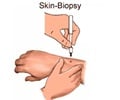It is common knowledge that itchy irritated skin can leave some people scratching their heads trying to determine the cause of this bothersome condition.
What did they touch? Is it just dry skin gone awry? Are they allergic to something in their home or workplace? The answers to these questions could require not only a little detective work, but the help of a dermatologist who can diagnose and treat the most likely culprit - contact dermatitis.Speaking today at the 68th Annual Meeting of the American Academy of Dermatology (Academy), dermatologist Joseph F. Fowler, Jr., MD, FAAD, clinical professor of dermatology at the University of Louisville in Louisville, Ky., presented the most common allergens that can cause contact dermatitis, including treatments and preventative measures that can be taken to improve this skin condition.
Contact dermatitis is characterized by a rash that can occur anywhere on the body (most commonly the hands and face) and is caused by something that comes into contact with the skin, leading to an allergic reaction. Irritated skin becomes dry and chapped and eventually red, scaly and inflamed. In many cases, these types of skin rashes require evaluation and treatment by a dermatologist who can determine the source of the rash and recommend the best treatment.
"In our everyday lives, we come into contact with a host of different substances and environmental elements that can have an adverse effect on our skin," said Dr. Fowler. "Sometimes when we have an allergic reaction to something, we might not be able to determine the source of the problem or it could take several days from the point of contact for a reaction to occur on our skin, which makes tracing the source extremely difficult."
 
Metals
Perhaps the most common form of contact dermatitis is metal allergy, with nickel being the most prevalent of all metal allergens. Dr. Fowler explained that almost every metal contains some amount of nickel, with costume jewelry and cell phones among the leading causes of allergic reactions.
"A person with sensitivity to nickel may not be able to wear jewelry that contains nickel or may find that holding a cell phone up against the ear will result in a rash and irritation where the device comes into contact with the skin - in which case a hands-free device, such as a plastic earpiece, or covering the metal with a plastic case will help," said Dr. Fowler. "Even gold is a fairly common allergen and can cause an adverse reaction in some people. The key is to identify the source and avoid contact with these products."
Skin Care Products/Cosmetics
Skin reactions can occur from ingredients in skin care products and cosmetics, with fragrances and preservatives topping the list of potential allergens. Dr. Fowler cautioned that even products labeled "dermatologist tested" or "doctor approved" does not mean that they won''t cause problems such as contact dermatitis. In fact, he added that products marketed as "natural" can cause reactions in people who may be allergic to the essential oils or herbal extracts contained in natural ingredients.
"There are thousands of fragrances and dozens of preservatives that can cause allergic reactions in people, ranging from itchy rashes to severe facial swelling," said Dr. Fowler. "If an allergy is suspected, particularly when a reaction occurs from a new cosmetic or skin care product being used for the first time, it''s important to discontinue the use of this product immediately and see a dermatologist if the condition does not improve within a few days."
In Hot Water from Frequent Hand Washing
While repeated hand washing has been touted during flu season as a major factor in preventing the spread of the virus, this good hygiene practice can spell trouble for the skin.
"Washing our hands can break down the skin''s natural protective barrier, causing the skin to crack, become inflamed and more at risk for developing allergies," said Dr. Fowler. "When this happens, hand dermatitis can occur."
Jobs in health care and other occupations that require repeated hand washing can predispose workers to hand dermatitis, and Dr. Fowler added that treatment should include applying a cream-based moisturizer immediately after hand washing to prevent the skin from drying too quickly.
Advertisement
Another common ingredient that can cause an allergic reaction in some individuals is neomycin. This ingredient is found in over-the-counter triple antibiotic ointments, which are used as a first-aid cream to treat cuts, abrasions and rashes. If an allergy to neomycin is suspected, Dr. Fowler recommended discontinuing the use of this product and consulting a dermatologist.
Dimethylfumate
Although furniture may not top the list of suspected allergens responsible for an outbreak of contact dermatitis, Dr. Fowler explained that the chemical dimethylfumate added into furniture made in China to prevent the growth of mold has been linked to severe rashes. Dimethylfumate is used in furniture (such as sofa or chair cushions) in little packages that can penetrate the fabric and subsequently clothing when a person sits on the furniture. Some people are very allergic to this preservative, and Dr. Fowler said that several cases have been reported in the United Kingdom, Canada and some Scandinavian countries - although reports have been less frequent in the United States.
Advertisement
In order to identify an allergen suspected of causing contact dermatitis, a dermatologist will use patch testing. This involves applying small concentrations of allergens to the skin on the arms or the back to see if a reaction occurs within three to five days. Once the allergen is confirmed, your dermatologist can provide recommendations for alternatives for that substance. For example, if you are allergic to nickel, your dermatologist may recommend having your jewelry plated in another non-irritating metal, such as platinum or sterling silver.
Treatments: Now and on the Horizon
The mainstay of treatment for contact dermatitis are topical corticosteroids, which are available over-the-counter and by prescription. In some cases, severe rashes may need to be treated with systemic corticosteroids (given orally or by injection), antibiotics, or other anti-inflammatory and immunologic agents. Dr. Fowler added that moisturizers, particularly creams that provide more persistent moisturizing effects than lotions, are extremely important and should be used regularly during treatment to prevent further dryness.
In addition, some new topical medications are undergoing clinical testing and may be helpful in treating contact dermatitis in the future. One oral medication, alitretinoin, is newly approved for chronic hand dermatitis in Europe and is now undergoing testing in the U.S.
"While we know that some people are more prone to contact dermatitis, we don''t fully understand why," said Dr. Fowler. "If we continue to learn more about the genetic component of this condition, then we might be able to develop new and improved treatments in the coming years. Until then, dermatologists can help patients manage this skin condition successfully."
Headquartered in Schaumburg, Ill., the American Academy of Dermatology (Academy), founded in 1938, is the largest, most influential, and most representative of all dermatologic associations. With a membership of more than 16,000 physicians worldwide, the Academy is committed to: advancing the diagnosis and medical, surgical and cosmetic treatment of the skin, hair and nails; advocating high standards in clinical practice, education, and research in dermatology; and supporting and enhancing patient care for a lifetime of healthier skin, hair and nails. For more information, contact the Academy at 1-888-462-DERM (3376) or www.aad.org.
Source-Newswise
RAS














